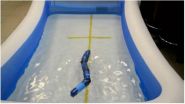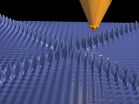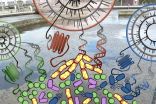How various brain areas interact in decisions
2014-11-26
(Press-News.org) The value of a piece of chocolate cake can change. Someone who happens to be on a diet is more likely to choose a fruit dessert and judge the calorie-laden cake as unhealthy. Previous studies have shown that a specific network in the brain is active when a person must decide between various choices that vary depending on context. They emphasize the interaction between neurons in two brain areas of the prefrontal cortex - the controlling area on the front side of the brain.
Prefrontal cortex shows increased activity in all decisions
Sarah Rudorf and Todd Hare of the Department of Economics of the University of Zurich were able to show those areas of the brain that are most active in the process of decision making in their new study. Their results indicate that the neuronal interactions between the so-called dorsolateral and ventromedial prefrontal cortex not only play a central role when a person needs to decide between several options, but also are decisive in general for flexible decision making. This contradicts the belief that increased activity in the prefrontal cortex only occurs when self-control is required when deciding between conflicting preferences.
Previously, situations in experiments were only examined where people had to reconcile contradictory wishes in order to achieve an objective. For example, subjects had to measure financial profits against fairness interests or immediate returns against long-term payments. Sarah Rudorf and Todd Hare wondered what happens in the brain if there are no contradictory wishes and no self-control is needed.
In their study, the scientists used functional magnetic resonance imaging to examine the brains of 28 subjects while they answered choice questions. The participants could opt for actions that were always associated with financial profit. However, the rules that defined when an action led to the largest payoff changed several times during the course of the study.
Points of interaction for new therapies
"Decisions that require self-control are extremely important, as they directly affect a person's bodily, social, or financial welfare," explains Sarah Rudorf. The determination of the mechanisms in the brain that are not only involved in decisions requiring self-control but that are also used in general decisions could open new points of interaction for therapies. "We could develop training programs that support certain decision skills in difficult situations that depend on self-control," concludes Todd Hare.
INFORMATION:
Literature:
Sarah Rudorf und Todd Hare. Interactions between Dorsolateral and Ventromedial Prefrontal Cortex Underlie Context-Dependent Stimulus Valuation in Goal-Directed Choice.
Journal of Neuroscience, November 26, 2014, 34(48):15988 -15996.
Contact:
Prof. Todd Hare
Institut für Volkswirtschaftslehre
Universität Zürich
Tel. +41 44 634 10 17
E-Mail: todd.hare@econ.uzh.ch
ELSE PRESS RELEASES FROM THIS DATE:
2014-11-26
On 24 October 2014, Sweden called off the hunt for a submarine after a week-long underwater search in the Stockholm archipelago. Triggered by a reported sighting of a Russian submarine, the alleged 'invasion' had been widely anticipated by military specialists and the media.
"Our assessment is that in the inner archipelago there was a plausible foreign underwater operation," Rear Adm. Anders Grenstad commented, "But we believe that what has violated Swedish waters has left."
"Whatever was there could not have been a conventional submarine," Grenstad said, but a "craft ...
2014-11-26
This news release is available in Japanese.
The deep ocean seems so remote that it is difficult to imagine any sort of human-generated change making an impact on deep-sea life. It is even more difficult to collect or examine evidence from the deep ocean to determine what those impacts might be. Enter the barnacle; a hard, sessile creature that looks like a tiny volcano and attaches to rocks, boat bottoms, and other hard substrates, where it filters ocean water to feed on tiny organisms. The barnacle holds clues about how climate change is affecting the deep ocean. ...
2014-11-26
KNOXVILLE - Warfare not only hastened human technological progress and vast social and political changes, but may have greatly contributed to the evolutionary emergence of humans' high intelligence and ability to work together toward common goals, according to a new study from the National Institute for Mathematical and Biological Synthesis (NIMBioS).
How humans evolved high intelligence, required for complex collaborative activities, despite the various costs of having a big brain has long puzzled evolutionary biologists. While the human brain represents only about two ...
2014-11-26
Published in the journal Nature, the discovery could revolutionise fuel cells and other hydrogen-based technologies as they require a barrier that only allow protons - hydrogen atoms stripped off their electrons - to pass through.
In addition, graphene membranes could be used to sieve hydrogen gas out of the atmosphere, where it is present in minute quantities, creating the possibility of electric generators powered by air.
One-atom thick material graphene, first isolated and explored in 2004 by a team at The University of Manchester, is renowned for its barrier properties, ...
2014-11-26
NGC 3532 is a bright open cluster located some 1300 light-years away in the constellation of Carina(The Keel of the ship Argo). It is informally known as the Wishing Well Cluster, as it resembles scattered silver coins which have been dropped into a well. It is also referred to as the Football Cluster, although how appropriate this is depends on which side of the Atlantic you live. It acquired the name because of its oval shape, which citizens of rugby-playing nations might see as resembling a rugby ball.
This very bright star cluster is easily seen with the naked eye ...
2014-11-26
Jülich, 26 November 2014 - In metals such as copper or aluminium, so-called conduction electrons are able to move around freely, in the same way as particles in a gas or a liquid. If, however, impurities are implanted into the metal's crystal lattice, the electrons cluster together in a uniform pattern around the point of interference, resembling the ripples that occur when a stone is thrown into a pool of water. Scientists in Jülich have, with the help of computer simulations, now discovered a combination of materials that strengthens these Friedel oscillations ...
2014-11-26
The Luxembourg Centre for Systems Biomedicine (LCSB) has succeeded for the first time in describing the complex relationships within an ecosystem in unprecedented detail. For their work, carried out in collaboration with US and Luxembourg partners, their model ecosystem was a "biological wastewater treatment plant". In it live numerous species of bacteria which are involved in the wastewater purification process.
LCSB director Prof. Dr. Rudi Balling stresses the medical importance of these research efforts: "Bacterial ecosystems also play a major role in our health. ...
2014-11-26
Although the van der Waals force was discovered around 150 years ago, it is still difficult to quantify when predicting the behaviour of solids, liquids, and molecules. Precise measurements were only possible up to now for single atoms or macroscopic objects. However, the van der Waals forces are particularly important at intermediate size, where they crucially co-determine the behaviour of complex molecules, such as biomolecules and proteins. They are also responsible for the functioning of certain adhesives and are the reason why geckos can adhere so amazingly well to ...
2014-11-26
This news release is available in French. The way people with autism spectrum disorder (ASD) gather information - not the judgement process itself - might explain why they gain different perceptions from peoples' faces, according to a new study from Hôpital Rivière-des-Prairies and the University of Montreal. "The evaluation of an individual's face is a rapid process that influences our future relationship with the individual," said Baudouin Forgeot d'Arc, lead author of the study. "By studying these judgments, we wanted to better understand how people with ...
2014-11-26
The precise movements of a young hammerhead shark have been tracked for the first time and are published in the open access journal Animal Biotelemetry. The study, which ran over a 10-month period, reveals important gaps in current efforts to protect these endangered sharks and suggests key locations that should be protected to help the survival of the species.
Hammerhead sharks, which have recently received new protections from the UN Convention on the Conservation of Migratory Species of Wild Animals, are experiencing drastic population declines in excess of 90% in ...
LAST 30 PRESS RELEASES:
[Press-News.org] How various brain areas interact in decisions





